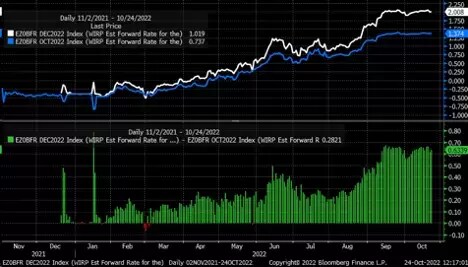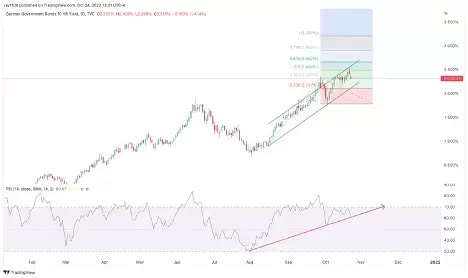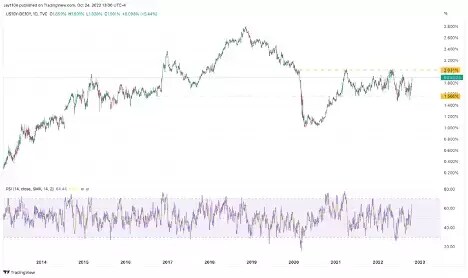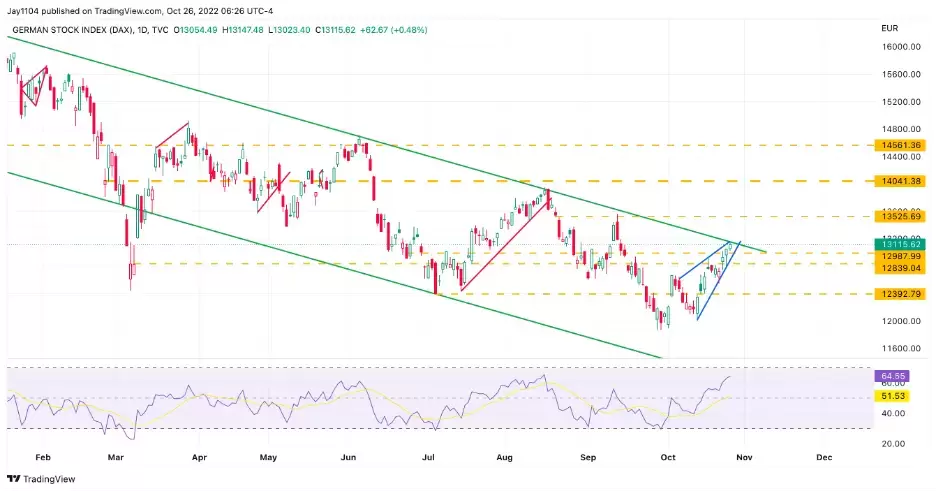With all eyes on the US Federal Reserve ahead of its monetary policy meeting on Tuesday, the market seems to have forgotten about tomorrow’s European Central Bank meeting.
Since early September, the market has expected the ECB to raise rates by a further 75 basis points (bps) on 27 October. Expectations haven’t really shifted, which may explain why tomorrow’s ECB meeting seems to have slipped from many investors’ radar.
However, the ECB’s forward guidance may be the most critical piece of information that comes out of the meeting. This is where the most significant market risk may lie. Currently, markets are looking for rates to rise by 63 bps in December versus October. In other words, consensus is split between a 50- and 75-basis-point hike at the December meeting.
Analyst expectations for ECB interest rates

ECB to raise rates by 50 or 75 bps in December?
Which way the ECB goes will largely depend on their view of the data. The latest inflation data would support the ECB raising rates by another 75 bps in December. The latest preliminary purchasing managers’ index (PMI) data for the eurozone are coming in at or below estimates, with a reading well below 50, suggesting that the eurozone economy is in contraction.
ECB likely to lean on data dependency
Unlike the Fed, which has the two main jobs of keeping inflation low and maximizing employment, the ECB doesn't have a dual mandate. Instead, the ECB can focus more squarely on inflation. That may partly explain why the ECB has the room to raise rates by 75 bps in December even though the eurozone economy may be heading toward recession. But nothing has been decided yet. It seems likely, given the data, that ECB policymakers would want to give themselves breathing room and leave investors guessing what their December move will be.
Weaker euro and higher rates
So, what can we expect from tomorrow’s meeting? A policy statement from the ECB that reads more to the dovish side of expectations would likely work to strengthen the dollar versus the euro. The euro’s decline versus the dollar has been orderly, as the chart below shows. But it also shows that the euro is very much at the upper end of its trading channel. At the same time, a decline to the lower end of the trading channel could potentially send the euro below €0.95 to the dollar. Additionally, as measured by the relative strength index, momentum is bearish, with a series of lower highs.

The thought process of a non-committal ECB on future rate hikes might make some investors expect rates to fall. And they may fall – at first. But it could also lead to rates rising longer-term. The market is likely to grow increasingly concerned that the ECB will be unable to contain inflation. In the long run, then, rates may need to go even higher.
German 10-year bonds on the rise
The 10-year German bund appears to have recently risen out of a bull flag, suggesting that the rate could climb to around 3.2% in the future. The relative strength index also indicates that momentum is bullish on rising rates.
German 10-year government bonds, knows as bunds

Additionally, the spread between the US 10-year and the German 10-year has been between 1.5% and 2% since January 2021, which means that German rates are likely to be supported by rising US rates irrespective of whether the ECB is hawkish or dovish. As long as the spread stays within this range, it suggests the German 10-year should trade within a range of 2.2% to 2.7%. It gives the German 10-year more room to the upside than it does at this point to trading on the downside.
US 10-year vs German 10-year government bonds

German stock market up since mid-October
Finally, Germany’s Dax index has recovered nicely off the mid-October lows. Over that time, it has been climbing and forming a rising wedge pattern. It is also approaching the upper end of its trading channel, which dates to early this year. These two patterns could be bearish for the Dax, and the region around 13,200 could serve as a reversal area. However, a dovish ECB meeting could result in the index extending further and rising to resistance around 13,500.
Germany’s Dax index

Should the ECB indicate a more aggressive monetary policy path, it could result in the opposite market reaction, with the euro strengthening versus the dollar and the long-dated bund yields trading lower. But given the limited visibility beyond this October meeting, it seems unlikely that the ECB will commit to another 75-basis-point hike in December. Instead, Europe’s central bank is likely to lean on data dependency.
Pricing is indicative. Past performance is not a reliable indicator of future results. The author's views and findings are his own and should not be relied upon as the basis of a trading or investment decision.
Disclaimer: CMC Markets is an order execution-only service. The material (whether or not it states any opinions) is for general information purposes only, and does not take into account your personal circumstances or objectives. Nothing in this material is (or should be considered to be) financial, investment or other advice on which reliance should be placed. No opinion given in the material constitutes a recommendation by CMC Markets or the author that any particular investment, security, transaction or investment strategy is suitable for any specific person. The material has not been prepared in accordance with legal requirements designed to promote the independence of investment research. Although we are not specifically prevented from dealing before providing this material, we do not seek to take advantage of the material prior to its dissemination.








